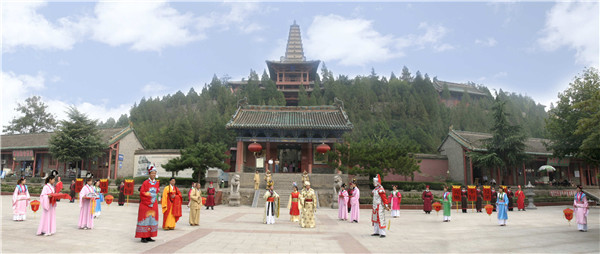
Pujiu Temple is located in the east of the ancient town of Puzhou, about 3 kilometers away from the Mountain Emei, the southwest of Yongji City, Shanxi Province. The temple sits in the north facing the south and its total area is about 93300 square meters with high-ground and wide field of view.
Pujiu Temple was founded in the Sui and Tang Dynasties, and it has more than 1000 years of history, where the love story of Zhang Sheng and Cui Yingying occurred in the Chinese famous classical drama of The Romance of the Western Chamber. In 1965, it was identified as a cultural relics protection unit in Shanxi Province, and in1985 a total of 4.35 million yuan was invested by the Shanxi Provincial Tourism Bureau for a comprehensive restoration. It has been opened to the public since 1990, and it was named a national 4A-level tourist attraction in 2002.
Pujiu Temple building is magnificent and unique. Its layout is three-story platform, which is from the upper, the middle to the lower and east-central three-axis (west axis for the Tang Dynasty, the central axis for the Song and Jin Dynasties, the east axis for the Ming and Qing system). The building pavilion, the corridor of the pagoda and the tower of the temple gives people a strong sense of solemn and beautifully handsome as it is closely related to the love story in The Romance of the Western Chamber closely related to the building: Zhang Sheng’s “West Pavilion”, Cui Yingying’s family home “Pear Flower House”. After the White Horse’s settlement, Zhang Sheng moved to the “Yard of Study” interspersed. Behind the temple is a lifelike garden. The risky rockery and the pavilion with double angle are vivid and impressed. The curly bridge over the Lotus pond connects the pavilions. The “Worship Moon Platform” of the heroine Yingying in the Chinese famous classical drama of The Romance of the Western Chamber is hidden among the green pine cypresses and thousands of bamboos.
Standing in the temple, the Yingying Tower is not only quaint, and spectacular in shapes, but also world-famous for the loud echo with the strange structure. Visitors in the tower side with a stone buckle, the tower will emit a crisp and pleasant voice which sounds like clams’ cry, so that visitors feel amazing. In the local records, it is called "toad voice in Pujiu Temple" in the ancient Times, one of the eight famous scenes.
It is because of the advent of the Chinese famous classical drama of The Romance of the Western Chamber, it wins a good reputation of the "World Buddha Temple”. The Shelita temple was also renamed "The Yingying Tower". Due to the beautiful and moving love story, it has been a famous tourist resort for thousands of years.
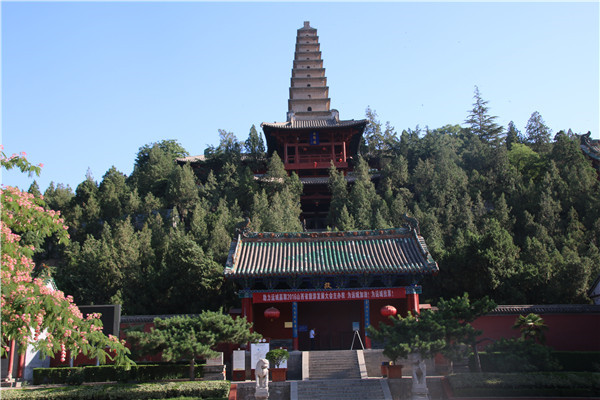
【Yingying Tower】
The Yingying Tower in the Pujiu Temple was built in 43rd year of Jiajing in Ming Dynasty, namely in 1564. It has a history of more than 400 years, with a height of 39.5 meters and thirteen floors which has a strange echo effect. Together with the Echo Wall of the Temple of Heaven in Beijing, Baolun Temple Tower in Sanmenxia, Henan, and "The sound of stone pedaling" in Dafo Temple, Tongnan County, Sichuan Province, they are known as China's classical garden of the four echo buildings. In the local records, it is called “toad voice in Pujiu Temple”, one of the eight famous scenes in ancient Yongji.

【The Backyard】
The Backyard is an attracting garden. The risky rockery and the pavilion with double angle are vivid and impressed. The curly bridge over the Lotus pond connect the pavilions. The “Worship Moon Platform” of the heroine Yingying in the Chinese famous classical drama of The Romance of the Western Chamber is hidden among the green pine cypresses and thousands of bamboos.
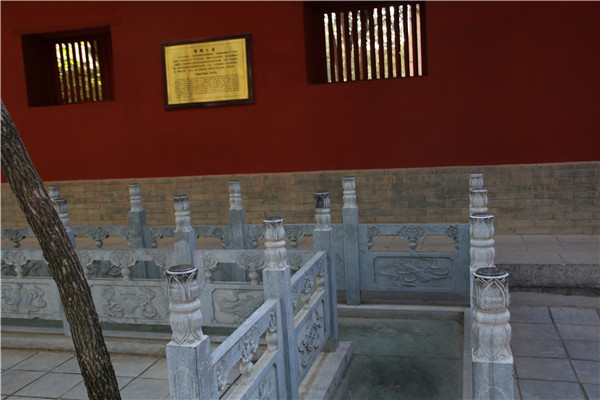
【Yingying Path】
In the summer of 1986, while repairing the foundation of the Pujiu Temple, it was found a side way one meter below the west surface of the Temple. According to research of experts, it belongs to the remains of the Tang Dynasty. Wang Jisi, a research expert on Chinese famous classical drama of The Romance of the Western Chamber, was interested in this trail and led the drama annual meeting scholars to investigate, which he thought was the path that Cui Yingying had walked on. Since then, this historical site has been called the Yingying Path.
【Xixuan Chamber (West Chamber)】
Xixuan Chamber is located in the west of the gallery and the Dafo Temple. It was restored in 1987. The house Zhang Sheng borrowed in the drama of The Romance of the Western Chamber refers to this chamber. After the white horse’s settlement, the old lady Lai denied, Zhang Sheng from here moved here to the east of the pear flower house.
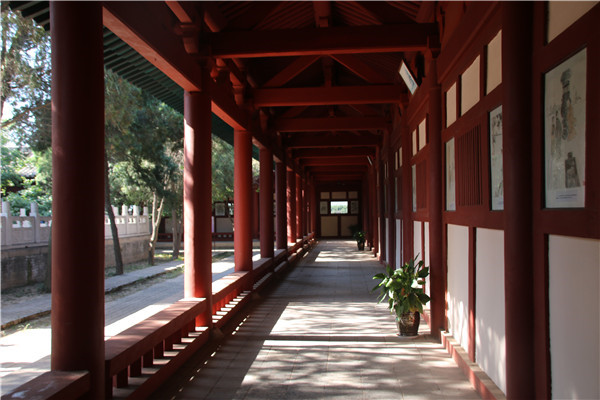
【Tayuan Gallery (The Tower Courtyard Gallery)】
The Tower Courtyard Gallery is the third building on the western axis of Pujiu Temple with the Tang Dynasty-shaped construction system. It has a total of 44 rooms. In front of the turtle scouring door, there is the rear with the wall door. The corridor defense is open and the perimeter set sitting railing with close structure. It is repaired in 1987 with the obvious characteristics of the times. In the classical drama of The Romance of the Western Chamber, it is recorded that Zhang Sheng visited the courtyard ascending the pagoda and circling the gallery.

【Dazhong Tower (Big Bell Tower)】
Big Bell Tower is the second on the western axis of Pujiu Temple with Tang Dynasty-shaped construction system. It has three main rooms with heavy eaves in Xieshan style, two-story flat to the top, the perimeter doors and windows, corridors and railings for visitors to look up. Dong Xieyuan was considered in the classical drama of The Romance of the Western Chamber to be that Zhang Sheng asked Faben, the old lady in charge of the tower to view the sightseeing.

【Pusa Cave (Bodhisattva Cave)】
The Bodhisattva Cave is behind the Tianwang Temple on the central axis of the temple. It is the only remaining millennium building in the former temple, and the cave is dedicated to the three Buddha statues of Wenshu, Guanyin and Puxian. According to expert’s recognition home, the view of the Guanyin statue has the charm of Song and Yuan Dynasties.

【Mituo Temple (Amito Buddha Temple)】
Amito Buddha Temple is located in the south of the central axis of the Pujiu Temple with the Song Dynasty-shaped construction system. Its width is as big as that of the three rooms with single eaves resting on the top of the mountain. In 1987, the top of the Bodhisattva Cave was repaired as a spacious platform for visitors to view and nap in front of the temple. This temple is named as the Amito Buddha, which comes from the sound of Sanskrit, meaning "infinite light", also known as the unprecious Buddha.

【Cangjing Pavilion (Depository Pavilion of Buddhist Texts)】
Depository Pavilion of Buddhist Texts is located in the north of the central axis of the Pujiu Temple with the Song Dynasty-shaped construction system. Its width is as big as that of the five rooms with three eaves and double layers resting on the top of the mountain. It is 20 meters high as the highest wooden building in the temple. Between the two-story columns with railings, available for visitors to look around. Restored in 1988, it was named after the Tibetan Buddhist Book. The scenes of the “Xiang Yun hanging over the Cabinet, Rei Ai vesturing the Bell Tower” depicted in Dong's the Romance of the Western Chamber refer to this pavilion.
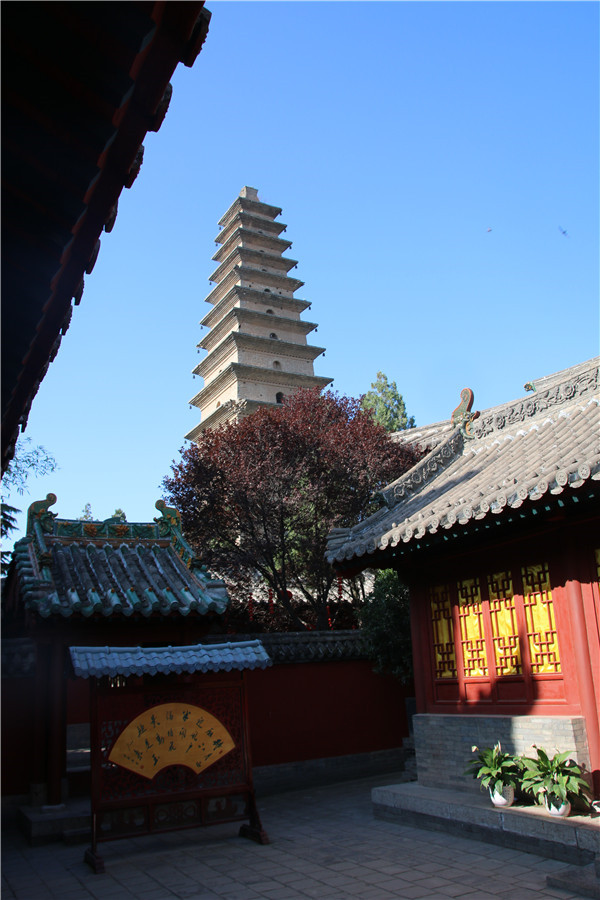
【Lihua Yard (Pear Flower Yard)】
The Pear Flower Yard is located between the Dafo Temple and the Cangjing Pavilion commonly known as the "Yingying Yard". It was restored in 1987. In the drama of The Romance of the Western Chamber, Yingying’s mother, Yingying and her matchmaker lived here. The room in the north is the old lady's residence; the room in the west is for the Yingying and her matchmaker and the room in the east for Huan Lang. The story of “amazing encountering", "denying marriage", "inviting dinner", “inquiring matchmaker” and other plots all occurred here.

【Shuzhai (the Study)】
The study is located in the north of the Cangjing Pavilion, next door to the west of the Lihua Yard. There is a study, bedroom with beautiful surroundings. Zhang Sheng moved from West Chamber to live here.
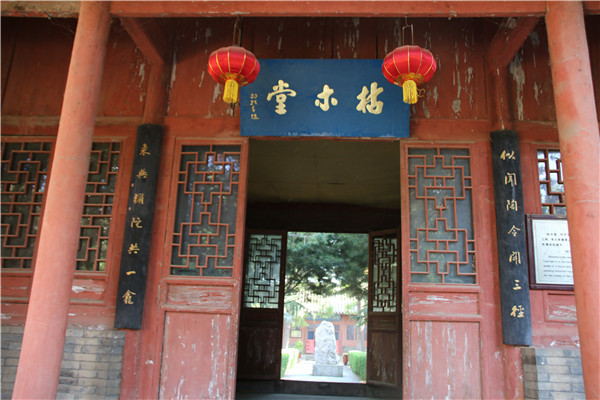
【Kumu Hall (Withered Wood Hall)】
Withered Wood Hall is located in the center section of the east axis of the temple with Ming Dynasty-shaped construction system. Its width is as big as that of three rooms with a single-eaves style. It was rebuilt in 1989, and now it has been the place where monks study the Buddhist scriptures.
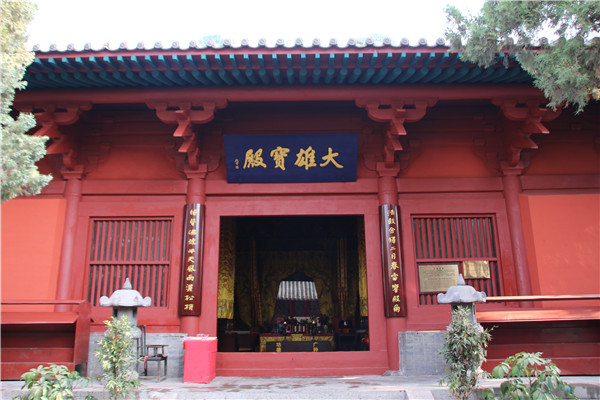
【Daxiongbao Temple(the Precious Hall of the Great Hero)】
Daxiongbao Temple is the place to held a grand Buddhist event. The three large stone Buddha statues on the Buddha is from the original site of one half of five places unearthed. It is the late North and South Dynasty relics according to the relevant experts identified. So it is a rare artistic treasure. Daxiongbao Temple is five rooms wide, three rooms in length, with single eaves.it is the most double imitation of architecture in the Tang Dynasty in the Pujiu Temple. "Zhang Junrui’s Disturbing" occurred here in The Romance of the Western Chamber.

Address:
Xixiang Village, Puzhou Town, Yongji City, Shanxi Province
Opening hours:
Peak season: 8:00——18:00
Off season:8:30——17:30
Scenic traffic guide:
Xi'an direction: You can go along the Lianho High-speed east to Qindong station, through the Fengling Yellow River Bridge into Shanxi, and then along the Yunfeng high-speed to Yongji West, and then along the brigade Travel 2 km west to reach the scenic spot.
Zhengzhou direction: You can go along the Lianho high-speed west to Qindong station, through the Fengling Yellow River Bridge into Shanxi, and then along the Yunfeng high-speed to Yongji West, and then along the brigade Travel 2 km west to reach the scenic spot.
Taiyuan direction: You can go along the Dayun high-speed south to Yongji West, and then along the tourist road 2 km west to reach the scenic spot.
High-speed railway line: take the Great Western High-speed rail Yongji North Station to get off, transfer line bus to Yongji bus station to get off 2 or 3 bus to reach the scenic spot.
Tickets:
Peak Season (April 1st-October 31st) 60 yuan / person;
Slack season (November 1st -March 30th) 50 Yuan / person.
Tour guide service:
50 RMB per time (less than 16 people)
60 RMB per time (more than 16 people)
Ticket and consultation hotline:
Consultation hotline: 400-114-0521
Ticket Center Tel: 0359-8485264
Temple scenic area, then transfer to te battery car to the Stork Tower Scenic Area.

